What is a Capo?
In its most basic form, a Capo is a clamp that fits across the neck of a stringed instrument, raising the pitch of the strings by a desired amount. It's name derives from the Italian capotasto, which translates literally to “head of the fretboard”. It was originally the term used for the nut of a stringed instrument but over the years the word has evolved into it's modern usage. Dating back over 300 years, the Capo has been developed and used on almost every stringed instrument imaginable, ranging from the guitar to the banjo to the bouzouki.
What does it do and what is it used for
This word Capo’s origin as “head of the fretboard” or “nut” is handy to keep in mind because the simplest way to think about the Capo is as a movable nut. A capo can be clamped behind any fret, making the playable portion of the guitar neck shorter and artificially raising the tuning of the guitar. For every fret away from the nut you place the capo you are then raising the pitch of each string by one half step*. For example, a guitar in standard tuning is tuned to E A D G B E (Figure 1). Let’s say you place a capo on the first fret of this same guitar. You’ve essentially moved the nut one fret closer to the bridge and raised the pitch of each string by a half step. so your guitar is in essence tuned to F A# D# G# C F (Figure 2). Remove the capo and place it on the third fret and you now have a tuning of G C F A# D G (Figure 3). In each case placing a Capo guitar has effectively been “retuned”, with each string being a number of semitones* higher, equal to how many frets you’ve moved the capo up the neck.
Figure 1 : A guitar in standard tuning with no capo.

Figure 2 : A guitar in standard tuning with a capo on the 1st fret
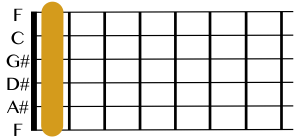
Figure 3 : A guitar in standard tuning with a capo on the 3rd fret.
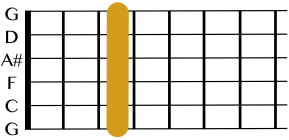
In most cases a capo is used by a guitarist as a simple means to change either the key or the voicing of the song they’re playing without the need to change the fingerings or use more complicated barre chords. Using a basic open G major chord shape on a standard tuned guitar will obviously give you a G major chord (Made up of the notes G, B and D. Figure 4). Now let's assume you've placed a capo on the 2nd fret. Using a G Major chord shape will now ring with the notes of an A Major chord (Made up of the notes A, C# and E. Figure 5).l
Figure 4 : A G Major chord shape with no capo.

Figure 5 : A G Major chord shape with a capo on the 2nd fret.
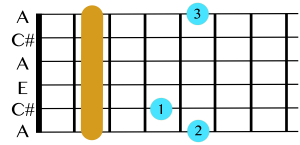
*half-step / semitone - A unit to describe the interval between two notes. A half-step or a semitone (the words are interchangeable) describes a note being 1 note, and therefore one fret away from another. For example a E and an F are one semitone apart, as are a C and a C#, etc.
How does this work in practice : Changing Keys on the fly.
To demonstrate the benefits of a capo it's probably best best to consider a real world example. Let's look at an American standard I’m sure many readers will know, “I Know You Rider”. While there are dozens of variations of this song on record in a multitude of keys, a simple version goes as follows:
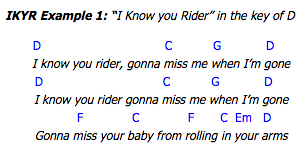
Option 1: Rework the song entirely As you can see, in this key it is a relatively simple song that can be performed exclusively with easy to play open chords. So let’s say you’ve learned this song in the key provided above. You’re utilizing the basic chord shapes and have worked out some fills you really like using passing notes on the open strings. Open mic night comes and you're ready to take this to the stage, only to meet a vocalist friend interested in playing the song with you. The only problem is they’re used to performing a step (two semitones) higher than you are. At this point you have two options:
It is possible to play the same chord progression in a different key by using a new set of chord formations. If your friend is used to playing the song a step higher, you can adjust the progression as follows:
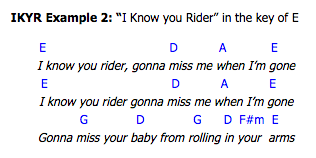
This solution works, but it is far from ideal. While you and your vocalist will now be playing in the same key every note of your carefully worked out fills are going to be in a completely different place on the neck. You're also going to have to introduce a more complicated F#m barre chord during the last line of the chorus in place of the much easier Em. Lucky for us, there is another option...
Option 2: Let the capo save the day! As we saw earlier, moving the capo up the neck has the same basic effect as moving the nut of your guitar, effectively shortening the length of your neck. Also, using the same formations you would use on a guitar without a capo will provide different chords when the guitar is capoed higher than the nut. So in the case of “I Know You Rider” instead of using new chord formations to play with our higher pitched vocalist as shown in Example 2, we can simply put a capo at the 2nd fret and use the exact same chord formations we would have used had we been playing it in the original key of D (IKYR Example 1). Our fills will also be in the same relative positions as they were in the original key. We, as the guitar players, still “feel” like we're playing it in the key of D, but the audience and the musician's playing with us will hear the song as E.
Taking it one step farther : Voicings and Experimentation
While it is possible (if somewhat inconvenient) to play “I Know You Rider” in different keys without the use of a capo, if you look through some of your favorite records I'm certain you'd find songs that would be nearly impossible to play in their intended key without the use of a capo. Just as some artists have songs written to be played only in specific alternate tunings, others will compose with the capo in mind from the outset, writing complicated voicings and picking patterns that would be impossible to play without a capo in place. If you're interested in listening to some examples, artists such as Ian Anderson, John Prine and Seth Avett have made extensive use of the capo throughout their careers.
Once you get used to using a capo and wrap your head around the underlying principles involved, you may also find new and unique ways to approach songs. As shown above, different capo placements allow a guitarist to change the key of the song they're playing while keeping the same fingerings and chord formations. As you advance you will also find that you find positions for the capo where you can use different chord formations to play the same chord! Just as you can play an open A major chord or an A major barre chord, you can also place the capo at the 5th fret and, using an open E chord, have your guitar voice an A major chord.
This is particularly useful when playing with multiple guitarists. Having two players strumming over the same chord in the same voicing can get tedious quickly. In a situation like this you can have one guitarist capo his guitar farther up the neck and, while playing in a different key relative to the capo, stay in the same concert key as the un-capoed guitarist. Getting to this point may take some practice and experimentation on a players part, but once the basics are learned a whole new world opens up on your guitar's neck.
Figure 6 and Figure 7 demonstrate how to use a capo along with varying chord formations to get new interesting voicings for your songs. Example 6 is a basic open E Major chord. If two guitarists are strumming over this chord at the same time can lead to a redundant, uninteresting arrangement. To add variation, a player can apply a capo at the 4th fret and then, using a C Major formation, play an E Major chord higher on the neck.
Figure 6 : A basic E Major chord formation with no capo.
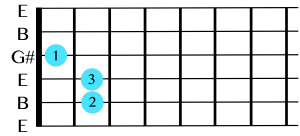
Figure 7 : A capo on the 4th fret means a C major chord shape can be used to play an E major chord.
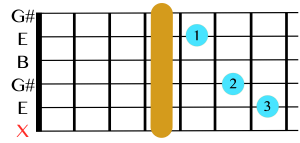
Types of Capos
Capos come in countless shapes and sizes. It would be impossible to account for every variation, here is a brief rundown of the most commonly found styles:

Kyser Quick Release
Quick release capos are the simplest Maury’s Music offers. They consist of two pieces of metal connected by a hinge with a spring to provide clamping tension. They are probably the most commonly found capo if only for their convenience. They can be put on and taken off in a matter of seconds and, when playing live, can be clamped on to the end of the headstock until you're ready to use it for ease of access. The only real negative of this style of capo is that the tension they provide is not adjustable. While they may work great on a guitar's first 4 or 5 frets, once they pass that point and the neck begins to get thicker they often provide too much downward force on the string, pressing down so hard the strings are bent out of tune. This excess tension can be compensated for by retuning the instrument after the capo is applied, but the guitar will have to be retuned again once the capo is taken off.
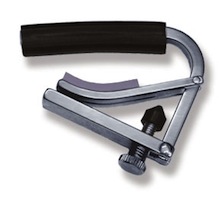
Shubb Capo
While similar in design to quick release capos, Shubb capos do not use springs to provide downard force on the string, but rather tension created by the flipping of a lever. While they do take longer to put on than a Quick Release capo, the fact that they can be adjusted so that they are providing only a minimum of downward force on the string means that they can be used without retuning the instrument. They are also very easy to take off as simply flipping the lever back releases all tension and frees the capo for removal.
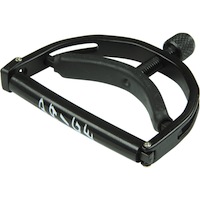
Paige Capo
The Paige design is another adjustable tension capo. Meant to be placed semi-permanently on the guitar, you simply slide the capo to the desired fret and then tighten the rear screw to your desired tension. Although harder to completely remove than the Quick Release and Shubb styles, a Paige capo can be loosened and slid behind the nut for storage during playing.
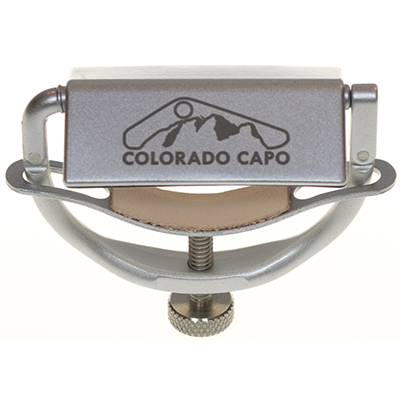
Colorado Capo
NEW for 2019! The Coloroado Capo is an improvement upon the yoke design. The leading edge of the blade allows you to get closer to the fret than any other capo, allowing for better intonation and provides better stability when bending notes. The frame of the capo sits farther back from the fret, allowing your hand more room for chords. "Out of the way so you can play" is the catch phrase here, and it really works - even for E and B7!

G7th
The G7th Capo uses a Wrap Spring Clutch design which allows for unprecedented control over the tightness of the capo. The G7th’s tension can be adjusted in extremely small increments, more than even the Shubb or Paige style capos.
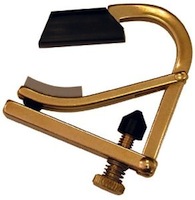
Partial capos
Partial capos are designed to hold down less than 6 strings at a time. Although not common these capos are popular among songwriters interested in experimenting with a variety of esoteric tunings. Definitely worth checking out for those looking to add something unique to your bag of tricks, but not recommended as your only capo.